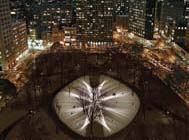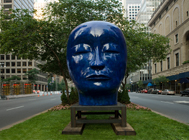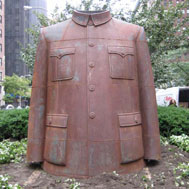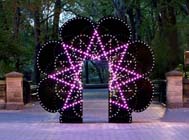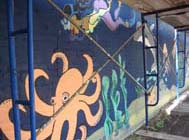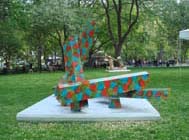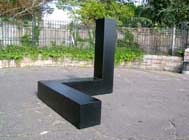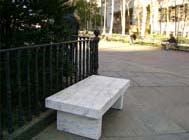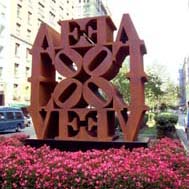Art in the Parks
Through collaborations with a diverse group of arts organizations and artists, Parks brings to the public both experimental and traditional art in many park locations. Please browse our list of current exhibits and our archives of past exhibits below. You can also see past grant opportunities or read more about the Art in the Parks Program.
Public Art Map and Guide
Find out which current exhibits are on display near you, and browse our permanent monument collection.
Search Current and Past Exhibits
2008
Manhattan
Rafael Lozano-Hemmer, Pulse Park
October 24 to November 17, 2008
Madison Square Park, Manhattan
Please note: This is a past exhibit that is no longer installed in the park.
Rafael Lozano-Hemmer combines seemingly disparate fields of architecture, digital media, robotics, medical science, and performance art into enormous temporary landscapes of light and rhythm that double as platforms for public participation.
Pulse Park is inspired by Roberto Gavaldon’s film Macario (Mexico, 1960) in which the protagonist has a hunger-induced hallucination wherein individuals are represented by lit candles. In Pulse Park, evening visitors to Madison Square Park will have their systolic and diastolic heart rates measured by one of two sensor sculptures installed at the North and South ends of the Oval Lawn. These biometric rhythms are translated and projected as pulses of narrow-beam light that move sequentially down rows of spotlights placed along the perimeter of the lawn as each consecutive participant makes contact with the sensors. The result is a communal expression of vital signs, transforming the public space into a fleeting architecture of light and movement.
Pulse Park be viewed nightly from dusk until 11:00 p.m.
This project is organized and sponsored by the Madison Square Park Conservancy.
![]()
Jun Kaneko, Heads
June 21 to November 16, 2008
Park Avenue Malls, Manhattan
Please note: This is a past exhibit that is no longer installed in the park.
Jun Kaneko is an internationally renowned artist known for his large ceramic sculptures. Three of the artist's largest sculptures, each entitled HEAD (2004 to 2007), are on view in the landscaped medians at 52nd, 53rd, and 54th streets.
Japanese-born Kaneko has been based in Omaha, Nebraska since 1986. His artwork appears in numerous international and national solo and group exhibitions annually, and is included in more than seventy museum collections. He has realized over thirty public art commissions in the United States and Japan and is the recipient of national, state, and organization fellowships.
![]()
Sui Jianguo, Mao Jacket
September 8 to November 15, 2008
Park Avenue at 70th Street, Manhattan
Please note: This is a past exhibit that is no longer installed in the park.
Coinciding with the exhibition Art and China's Revolution, Asia Society and the NYC Department of Parks & Recreation present a 10-foot high Mao jacket sculpture created by Sui Jianguo (b. 1956, China), one of the most important contemporary Chinese sculptors working today. The Mao jacket is part of the series "Legacy Mantle" for which he is best known. The four-ton metal jacket is three meters high, 2.5 meters wide, and 1.5 meters deep.
Since the late 1990s, the artist has adopted two motifs for which he is now widely known: dinosaurs and the Mao jacket. The iconic Mao jacket, emptied of its signature occupant, appears in monumental fiberglass and in smaller-sized versions made of aluminum and other materials. At times, Sui Jianguo combines the two motifs, as in Sleeping Mao, in which a fiberglass sculpture of the legendary leader reclines on thousands of tiny dinosaurs. Sui Jianguo has exhibited internationally. He is based in Beijing, where he heads the sculpture department at the Central Academy of Fine Arts.
![]()
James Yamada, Our Starry Night
April 21 to November 12, 2008
Doris Freedman Plaza
Central Park, Manhattan
Please note: This is a past exhibit that is no longer installed in the park.
Built from powder-coated aluminum and punctuated with 1,900 colored LED lights, Our Starry Night is a 12-foot-tall sculpture that acts as an interactive passageway to Central Park. When visitors walk through the portal, they trigger a metal detector hidden inside the structure's casing that activates the LED lights on the exterior of the sculpture. The sculpture is only illuminated while the participant is standing within the passageway, and therefore he or she is not able to see the light patterns being created on the exterior surfaces. Instead, the lighting is visible to passersby on the street corner and in the park.
In this work, Yamada calls our attention to the expanding, yet increasingly subtle, presence of surveillance in the contemporary world. It also points towards such philosophical and political considerations as the loss of privacy in the name of greater safety and the use of personal information.
This is a project of the Public Art Fund.
![]()
Dennis Oppenheim, Tumbling Mirages
June 12 to November 9, 2008
Union Square Park, Manhattan
Please note: This is a past exhibit that is no longer installed in the park.
Tumbling Mirages consists of three spheres 15 feet in diameter, made of steel and fiberglass. Oppenheim's new work follows a long trajectory from his early rejection of the gallery space in favor of the outdoors and even his own body as sites for art. His first earthworks in 1967 "brought the land and the soil into the work itself." Oppenheim has shown extensively in major galleries and museums around the world.
"Tumbling Mirages are a hybrid sculpture, combining the characteristics of tumbleweed with the optical illusion emanating from a desert mirage," says the artist. "Although these works are shown in New York City at Union Square, they are conceived to operate on the desert floor of Arizona, where they can tumble, reflecting and distorting the desert landscape through their reflective surfaces."
![]()
Adam Peachy and James Evans, Mural
October 2007 to October 2008
Baruch Playground, Manhattan
Please note: This is a past exhibit that is no longer installed in the park.
At Baruch Playground in Manhattan's Lower East Side, painters Adam Peachy and James Evans organized a team of volunteers to complete a mural of an underwater scene. It is a project of CITYarts. CITYarts is a nonprofit organization that connects children and youth with professional artists to create public art that addresses civic and social issues, impacts their lives, and transforms their communities. Since its founding in 1968, CITYarts has engaged nearly 100,000 New Yorkers of all ages and backgrounds with over 500 professional artists in the process of designing and creating more than 260 murals, mosaics, and sculptures. Special emphasis is given to neighborhoods where access to and participation in the arts is limited.
![]()
Richard Deacon, Assembly
May 15, 2008 to August 24, 2008
Madison Square Park, Manhattan
Please note: This is a past exhibit that is no longer installed in the park.
This exhibition consists of seven large, brilliantly-colored ceramic sculptures placed throughout the park’s lawns. Deacon, an internationally recognized sculptor, is known for his experimentation with a wide variety of materials in his exploration form. Recently the artist has been exploring clay and ceramics as materials for sculpture. His new Assembly series, on view in the park, is group of four variations on geometric relationships, each presenting an economy of form crossed with an earthly solidity: large-scale, elegant structures composed of richly glazed and patterned ceramic elements that present a tactile and visual sculptural experience.
Richard Deacon was born in Bangor, Wales in 1949. He has occupied the foreground of British sculpture for the past three decades and has had a major presence around the world as highly respected sculptor. Last summer, he was selected to represent Wales Pavilion at the 52nd Venice Biennale. In 1999, he was awarded CBE, Commander of the British Empire. In 1998, he was elected to the Royal Academy, London. In 1997, he received the Chevalier de l’ordre des arts et lettres from the French Ministry of Culture. In 1987, was honored with the Britain’s prestigious Turner Prize.
Assembly is a project of Mad. Sq. Art.
![]()
Tony Smith, Free Ride (1962, refabricated 1982)
October 31, 2007 to May 30, 2008
Carl Schurz Park, Manhattan
Please note: This is a past exhibit that is no longer installed in the park.
Tony Smith’s (1912-1980) painted steel sculpture Free Ride is a study in planes and angles. The geometric work, in some ways a simple black structure, becomes complex through its range of views. Each vantage the sculpture is viewed from offers a different angle and a different shape to the form. Smith’s work is not a sculpture for passive viewing; instead it invites engagement and thought, provoking a response in the viewer.
Tony Smith was trained and spent a good portion of his life as an architect. His introduction to art was through painting, and he did not begin his career as a sculptor until he was 44, in 1956. Smith was highly influenced by other minimalist, monumental sculptors, such as Barnett Newman, and first exhibited his sculptural work in 1964. He was the first artist to exhibit work in New York City Parks with his 1967 show in Bryant Park.
On loan from the Museum of Modern Art, New York.
![]()
Jenny Holzer, Truisms Bench
October 22, 2007 to May 15, 2008
Columbus Park, Manhattan
Please note: This is a past exhibit that is no longer installed in the park.
Jenny Holzer’s Bench is part of the artist’s most famous series of work, her "truisms." These seemingly simple aphoristic phrases reveal themselves, upon closer inspection, to be slyly subversive. Holzer has used a variety of media, including LED signs, plaques, stickers, and T-shirts, to bring her words and ideas into the public sphere. A grouping of the artist’s benches was shown by the Public Art Fund in a 1989 installation in Central Park’s Doris Freedman Plaza.
![]()
Robert Indiana, Love Wall
October 1, 2007 to May 15, 2008
Park Avenue Mall at 57th Street
Park Avenue Malls, Manhattan
Please note: This is a past exhibit that is no longer installed in the park.
Robert Indiana’s bronze Love Wall is a reworking of one of the artist’s most iconic images. The "Love" image, the word "love" in all capitals, arranged in a square with a tilted "O," was originally developed by the artist for use as the Museum of Modern Art’s Christmas card in 1964 and shown as a sculpture in Central Park in 1969. Since its inception, various sculptural incarnations of the sculpture have been installed on Sixth Avenue in New York City, The Indianapolis Museum of Art, New Orleans Museum of Art, in the city of Taipei, Taiwan, as well as in Singapore, Bilbao, Spain, and Vancouver, Canada. There is also another version of the sculpture, spelling out "ahava" (“love” in Hebrew) on display at the Israel Museum in Jerusalem. Ahava was shown in Central Park’s Doris Freedman Plaza for a four-month period in 1978, prior to its installation at the Israel Museum.
![]()
